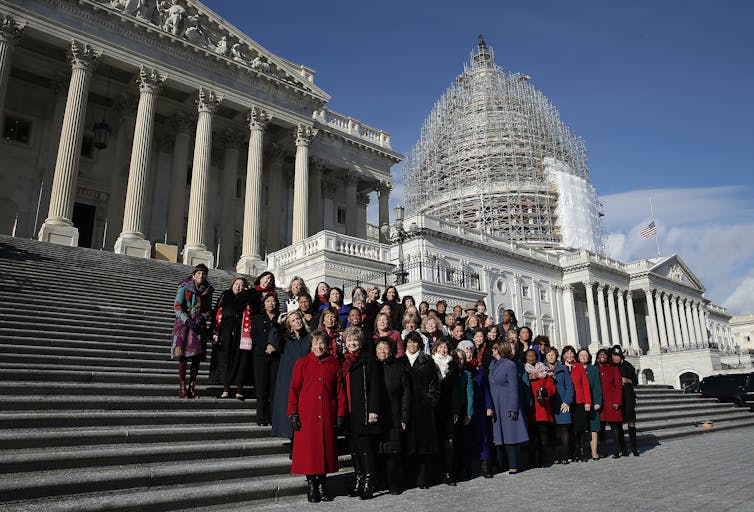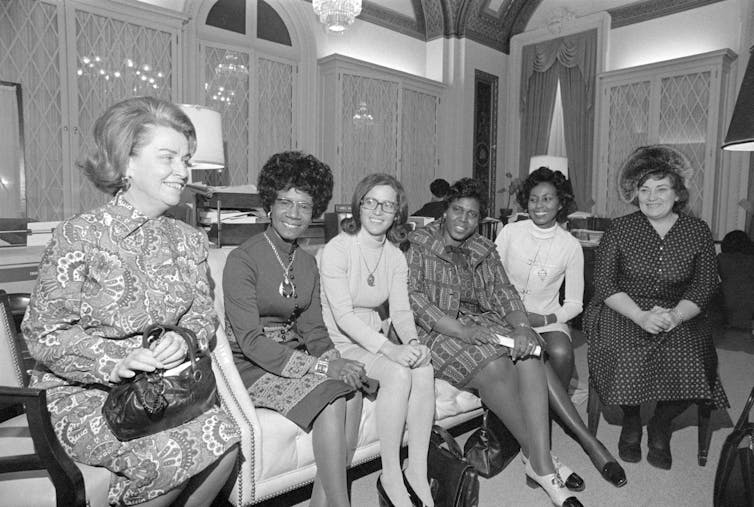Laurel Elder, Hartwick College
When the 118th Congress convenes on Jan. 3, 2023, the number of women among its 535 members will inch up by just two – increasing from 147 in 2022 to 149 in 2023.
Even though more women than men voted in the the 2022 midterm elections, women’s representation in Congress, with a total of 535 members, will then stand at just 27.9%.
At this rate, it will take 118 more years – until 2140 – for there to be an equal number of male and female lawmakers in Congress.
The slow progress of women in elective office is frustrating for some political observers and experts – including myself – who believe that achieving gender equality in Congress is an important goal.
I am a political science scholar who has spent 20 years researching the reasons for women’s underrepresentation in elected office in the United States.
This issue is important because how many women there are in the room when legislative decisions are made has significant consequences for the policies that governments enact. Female legislators are more likely than men to introduce, speak about and work to pass policies that disproportionately affect women and girls, such as paid family leave, pay equity and gender-based violence.
Having more women in Congress also strengthens female voters’ sense of connection with the government. It also bolsters women’s sense that government cares about their concerns and inspires young women to become more politically engaged.

What’s behind this sluggish pace
While women are underrepresented in governments around the globe, it is a particularly significant problem in the United States. Currently, the U.S. ranks 73rd in the world when it comes to female representation in government.
But the reason women are so dramatically underrepresented in U.S. government is not because they face resistance from voters or struggle to raise money. On the contrary, decades of research shows that when women run, they raise as much money and win as often as similarly qualified men.
In my 2021 book, “The Partisan Gap,” I show that the slow progress of women in politics is a tale of two political parties.
In the next Congress, there will be 107 female Democratic lawmakers and 42 female Republican lawmakers in the Senate and House combined.
In other words, Democrats will compose 72% of the women in Congress. Despite Democrats losing nine congressional seats during the November 2022 midterms, the number of Democratic lawmakers in Congress who are women will remain steady.
The gap between elected Republican and Democratic female lawmakers in Congress has widened over the past four decades.
A divergence
In the 1970s and 1980s, there were few women in Congress, but those trailblazers were equally likely to be Republicans or Democrats. For example, in 1981 there were 25 women in Congress – 13 Republicans and 12 Democrats.
This shifted, though, as the two political parties moved further apart ideologically, with Democrats becoming more liberal overall – and on women’s issues in particular. Pushed by feminist organizations, the Democratic Party took more steps to increase women’s representation throughout the 1980s. The emergence of EMILY’s List, which seeks to elect pro-choice women, has also proved to be a powerful asset in recruiting and supporting Democratic women candidates.
As more female Democrats gained leadership posts in Congress, starting in earnest in the 1980s and culminating in the election of Nancy Pelosi as the party’s leader in the House in 2004, they were well positioned to translate this rhetoric into reality. Women have more women in their personal and professional networks than men do, and therefore are better positioned to recruit other women to run.
Women from the Democratic party have made steady gains in office since the 1990s and are on a clear trajectory to reach 50% of their party caucus in just a few more election cycles.
When Pelosi announced in November 2022 that she would not run again for the House speaker position, she noted, “When I came to the Congress in 1987, there were 12 Democratic women. Now there are over 90. And we want more.”
Progress for conservative women in politics, however, largely stalled in the 1990s.

Getting more Republican women in office
When I interviewed Republican women in Congress for my book, they agreed that more women representing their party were needed because they bring a different perspective on issues than their male colleagues.
But the Republican Party’s increasing conservatism has made it harder for women running as Republicans to win elections, as it has not made encouraging more women to run for office a priority. This creates additional challenges for potential Republican female candidates, since women typically need to be encouraged by others to consider running for office.
So, what will it take to get more Republican women to run? The Republican Party would need to commit more fully to recruiting and supporting female candidates.
In the 2018 elections, the number of Republican women in the House dropped to a mere 13, the lowest level in two decades. In response, Republican House member Elise Stefanik started the political action group Elevate-PAC to identify, cultivate and support Republican female candidates. Although Stefanik faced criticism from her party for this move, her efforts paid off with 31 Republican women elected in 2020.
In order for women to gain half of the seats in Congress, more women need to run, especially on Republican tickets. I believe that this will require the Republican Party as a whole to prioritize recruiting women – and not just for one election cycle, but in a sustained way.
Laurel Elder, Professor of Political Science, Hartwick College
This article is republished from The Conversation under a Creative Commons license. Read the original article.







